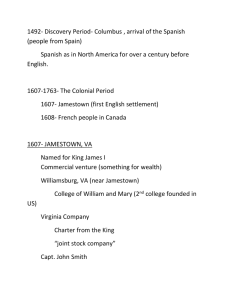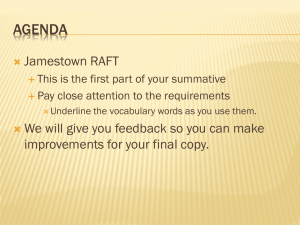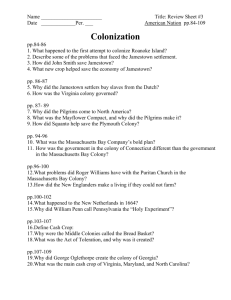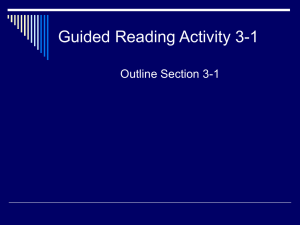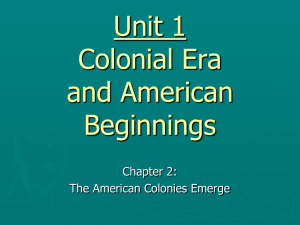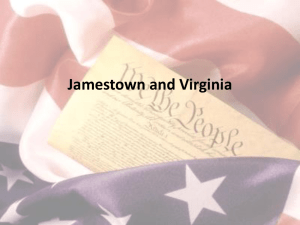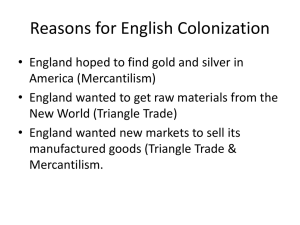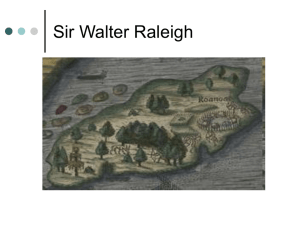The Jamestown Colony Lesson Plan
advertisement
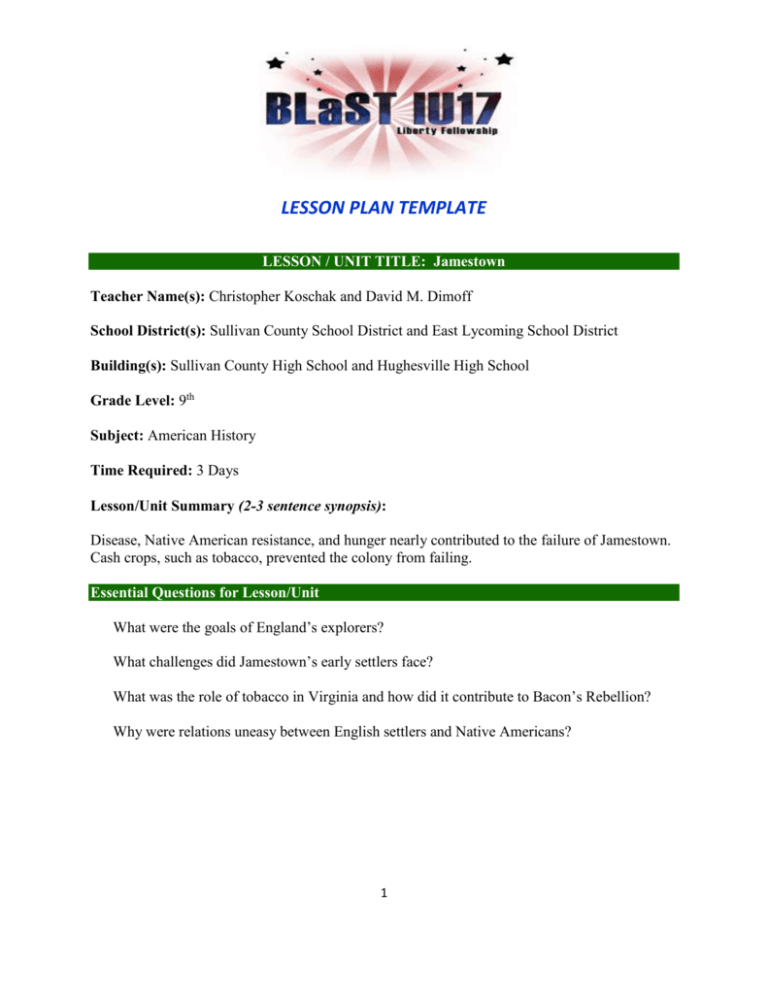
LESSON PLAN TEMPLATE LESSON / UNIT TITLE: Jamestown Teacher Name(s): Christopher Koschak and David M. Dimoff School District(s): Sullivan County School District and East Lycoming School District Building(s): Sullivan County High School and Hughesville High School Grade Level: 9th Subject: American History Time Required: 3 Days Lesson/Unit Summary (2-3 sentence synopsis): Disease, Native American resistance, and hunger nearly contributed to the failure of Jamestown. Cash crops, such as tobacco, prevented the colony from failing. Essential Questions for Lesson/Unit What were the goals of England’s explorers? What challenges did Jamestown’s early settlers face? What was the role of tobacco in Virginia and how did it contribute to Bacon’s Rebellion? Why were relations uneasy between English settlers and Native Americans? 1 LESSON PLAN TEMPLATE Pennsylvania Academic Standards Addressed in Lesson/Unit 8.1. Historical Analysis and Skills Development A. Analyze chronological thinking. B. Analyze and interpret historical sources. C. Analyze the fundamentals of historical interpretation. D. Analyze and interpret historical research. 8.3. United States History A. Identify and analyze the political and cultural contributions of individuals and groups to United States history. B. Identify and analyze primary documents, material artifacts and historic sites important in United States history. C. Analyze how continuity and change has influenced United States history. D. Identify and analyze conflict and cooperation among social groups and organizations in United States history. Lesson/Unit Objectives At the conclusion f this lesson, students will be able to: 1. 2. 3. 4. Identify the goals of England’s explorers. Describe the challenges faced by Jamestown’s early settlers. Explain the role of tobacco in Virginia and how it contributed to Bacon’s Rebellion. Understand why relations were uneasy between English settlers and Native Americans. 2 LESSON PLAN TEMPLATE Vocabulary/Key Terms for Lesson/Unit Bacon’s Rebellion: revolt against the government of Jamestown charter: certificate of permission House of Burgesses: colonial legislature whose representatives were called burgesses joint-stock company: a company funded by a group of investors indentured servants: person who contracted to work for a master legislature: lawmaking assembly privateer: ship hired by government to attack foreign ships royal colony: colony whose governor is appointed by the king Historical Background for Teachers / Research Narrative The Settlement of the North America English Colonies. Strike out at Roanoke. In 1586, the English first tried to set up a permanent colony at Roanoke on the Outer Banks of North Carolina. But the war with the Spanish and the Spanish Armada stifled the attempt. Sir Walter Raleigh thought he would return within a year to resupply the colony, but he was unable to due to the threat to the English homeland. Finally, when the English supply ship returned, nothing was found of the colony except the word “CROATOAN” carved into a tree. The colonists had disappeared and Roanoke has since been identified as the” Lost Colony”. Finally, the English were able to gain a foothold in North America with Jamestown. Jamestown had many difficulties achieving permanence. The original settlers were mostly gentlemen without the work ethic or status to take on the work needed to make the colony successful. In addition to the problems caused by the selection of original colonists, another issue was the choice of location for the settlement. The Jamestown endeavor was financed and planned by a joint-stock company called the Virginia Company. The Virginia Company chose a site located in the middle of a Native American empire that was poorly suited for settlement due to swampy land which was an incubator for disease. John Smith is 3 LESSON PLAN TEMPLATE credited with saving the colony through his leadership and bargaining with the Native Americans especially Pocahontas, but the true catalyst that allowed Jamestown to be successful was John Rolfe and his tobacco seeds, which made the colony profitable. Once the colony was established and making a profit, a method of attracting settlers had to be established. The method chosen was indentured servitude. Indentured servants would trade passage aboard ships to Virginia for committing to 3-7 years of labor on the plantation that financed their trip to the colony. The original African-Americans to land in Virginia were treated as indentured servants when a Dutch Ship arrived in 1619. It is important to note in the study of colonization that, from the start, the English and the Native Americans had disputes. Who could blame the Native Americans? It was their land, and now a foreign power was claiming the land as their own. This problem grew as the population increased and more land was acquired from the Native Americans. The land on the coast was continually developed and those settlers lucky enough to have had timing and money to establish themselves on the coast were doing fine. But as indentured servants paid off their debt with time, they had to move inland to acquire land to make a living on their own. As settlers tried to move inland, the competition for land between the former indentured servants and Native Americans came to a head, most notably in 1676 with Bacon’s Rebellion. The Rebellion started with clashes between settlers and Native Americans but ultimately exposed the economic differences between those on the coast and those inland. Bacon’s Rebellion was the most significant uprising against English rule until 100 years later with the American War of Independence. Sources: America Pathways to the Present, Prentice Hall, 2005 Cicero: History beyond the Textbook (http://cicerohistory.com/), 2011 4 LESSON PLAN TEMPLATE Instructional Prodedures and Activities Day 1: (Guided/Independent Practice) 1. Students will read Chapter 2, Section 2: Jamestown. 2. During their reading, students will identify confusion, main ideas, and supporting details. Student will use different color highlighters to identify confusion, main ideas, and supporting details. 3. Students will define the key terms on the Cicero vocabulary worksheet. 4. Students will answer the Reading Focus/Essential Questions. 5. Students will complete the Learning Focused Schools Main Idea graphic organizer. 6. Students will answer the Section 2: Assessment questions. Day 2: (Student Centered) 1. Students will participate in a student driven exploration. 2. During the exploration, students will review the day one assignments, and they will participate in an activity that will alleviate their confusion. 3. Students will complete the Jamestown Adventure. http://www.historyglobe.com/jamestown/ 5 LESSON PLAN TEMPLATE Day 3: (Teacher/Student Centered) 1. Students will complete the Chapter 2, Section 2 Jamestown Power Point Notes. 2. Upon completion of the notes, students will complete the Chapter 2, Section 2 Jamestown’s Power Point quiz. Suggested Strategies for Differentiating Instruction 1. Victor Reader: America Pathways to the Present - textbook on CD 2. Chapter 2 Section 2: Jamestown Power Point Notes (Adapted) 3. Adapted Assignments: Cicero Vocabulary Worksheet; Learning Focused Schools Main Idea Graphic Organizer; 4. Adapted Assessments: Section 2.2 Power Point Quiz, Chapter 2 Section 2.1/2.2 Vocabulary Quiz; Chapter 2 Examination Assessment of Student Learning (Formative and Summative) Formative: Teacher observation/discussion Evaluation of class work assignment and graphic organizers Chapter 2, Section 2 Power Point Quiz Chapter 2, Section 2.1/2.2 Vocabulary Quiz Summative: Exam 2: European Colonization of the Americas, 1492–1752 American History Final Examination 6 LESSON PLAN TEMPLATE Materials and Resources 1. America Pathways to the Present – Prentice Hall, 2005 2. Chapter 2 Section 2: Jamestown Power Point Notes 3. Chapter 2 Section 2: Jamestown Power Point Quiz 4. Learning Focused Schools Main Idea Graphic Organizer Author(s) of Unit/Lesson Plan Christopher Koschak, Sullivan County School District, Sullivan County Senior High School David M. Dimoff, East Lycoming School District, Hughesville High School 7

